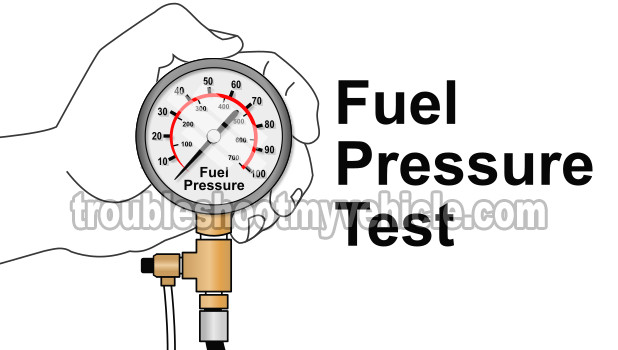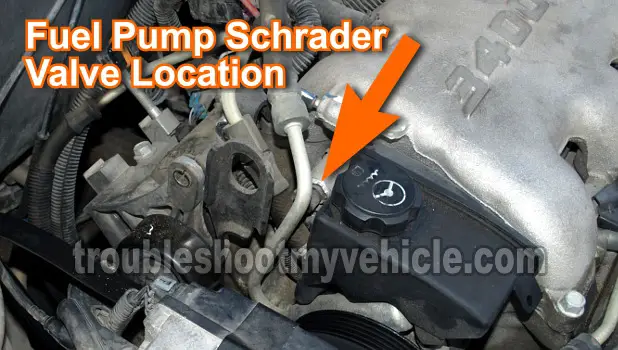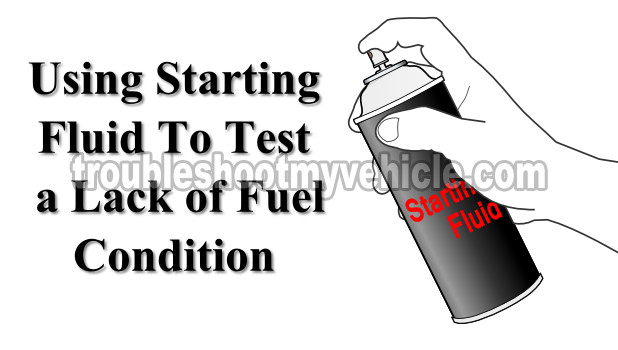
I'm going to show you two different methods to verify if the no-start condition on your 3.1L or 3.4L GM vehicle is due to a lack of fuel, which usually means that the fuel pump has gone bad.
One method involves using just starting fluid and the other involves using a fuel pressure gauge. One method is a very accurate way of diagnosing a lack of fuel condition causing a no-start. The other method is not that accurate.
I've used both methods successfully and I'll describe them in a step-by-step way in this tutorial.
Contents of this tutorial:
IMPORTANT: Gasoline is extremely flammable. Be careful and take all necessary safety precautions. Use extreme care when using starting fluid since it ignites as easily as gasoline. Accomplishing both tests indicated in this article, without any unhappy consequences, is more than possible if you're careful and use common sense.
ES ![]() You can find this tutorial in Spanish here: Cómo Probar La Bomba de Combustible (GM 3.1L, 3.4L) (at: autotecnico-online.com).
You can find this tutorial in Spanish here: Cómo Probar La Bomba de Combustible (GM 3.1L, 3.4L) (at: autotecnico-online.com).
Symptoms Of A Bad Fuel Pump
A bad fuel pump will make your 3.1L or 3.4L Venture (or Malibu, Regal, Skylark, Corsica, Impala, Venture, etc.) crank but not start. Here are some more specific symptoms:
- All of the coil packs, sitting on top of the ignition control module, are creating and delivering spark to the spark plugs. So you know that the ignition system is not at fault.
- You've sprayed starting fluid (or carburetor spray) into the throttle body and your vehicle started, even if only momentarily.
Although the above list is a not a very complete list of symptoms, the theme that runs thru' them, and any other related symptom, is that the engine will crank and crank, but not start.
Which And Where To Buy A Fuel Pressure Gauge
Owning a fuel pressure gauge is now becoming a must. All vehicles now use an electrical fuel pump to deliver fuel (under high pressure) to the fuel injectors and the best way to diagnose this fuel pump is with a fuel pressure gauge.
As mentioned earlier (in fuel pump TEST 2), in all of the GM 3.1L and 3.4L V6 equipped vehicles GM was kind enough to put a Schrader valve on the fuel injector rail where you can tap into the fuel system and check its performance.
A fuel pressure gauge can cost you as little as $40 (US) or as much as $200 (US). The price difference depends on what type of fuel pressure gauge set you buy, this means either buying a non-professional technician grade tool or a professional technician grade too. Whichever one you buy, it's an investment that will pay for itself many times over.
Here are my recommendations:
Disclosure: As an Amazon Associate, I earn from qualifying purchases. If my tutorials help you, using these links is an easy way to support the site at no extra cost to you. Thank you!
NOTE: All of the kits above have the adapter for the GM Schrader valve that you'll need to test your vehicle.
FUEL PUMP TEST 1: Fuel Pressure Test With Gauge

Testing the fuel pressure with a fuel pressure gauge can be very easily done on your 3.1L or 3.4L Monte Carlo (Venture, Beretta, Corsica, Lumina, Monte Carlo, Grand Prix, Grand Am, Cutlass Supreme, etc.). This is due to the fact that GM has included a Schrader valve on the fuel rail to which you and I can attach a fuel pressure gauge to.
Using a fuel pressure gauge to make sure that enough fuel is reaching the fuel injectors is the most accurate way to diagnose the fuel pump in your car or mini-van.
If you don't own a fuel pressure gauge, you can rent one from your local auto parts store (AutoZone, O'Reilly Auto Parts). If you're interested in buying your own, check out my recommendations here: Which And Where To Buy A Fuel Pressure Gauge.
OK, let's get started with this test:
- 1
Connect the fuel pressure gauge to the Schrader valve on the fuel rail.
With a shop towel, mop up any fuel that was released during the process of connecting the fuel pressure test gauge. - 2
When ready, ask your helper to crank the engine a few seconds while you check for fuel leaks at the Schrader valve.
If a fuel leak is present, resolve it before continuing to the next step. - 3
Ask your helper to crank the engine while you observe the fuel pressure tester's gauge.
- 4
Your fuel pressure gauge will register one of the two following results:
1.) The fuel pressure gauge will register 35 PSI.
2.) The fuel pressure gauge will register 0 PSI.
OK, now that the testing part is done, let's take a look at what your results mean:
CASE 1: If the fuel pressure gauge registered 0 PSI. This confirms that the cause of your Venture's (Malibu, Impala, Lumina, Grand Am, Cutlass Supreme, etc.) is caused by a lack of fuel.
Now, I usually take one more precaution, before condemning the fuel pump as bad and this is to check that the fuel pump is getting 12 Volts as the engine is cranking. This is just to make sure that the fuel pump relay and fuse are OK and doing their job.
What you'll have to do to accomplish this is to attach a multimeter in Volts DC mode to the wire that supplies this voltage to the fuel pump and while a helper cranks the engine, verify that the fuel pump is getting this power. If the 12 Volts are being supplied to the fuel pump, then you have now 100% verified that the fuel pump is fried and needs to be replaced.
CASE 2: If the fuel pressure gauge registered 35 PSI. This fuel pressure gauge result lets you know that the fuel pump is working and delivering enough fuel to the fuel injectors. The reason your 3.1L or 3.4L GM vehicle is not starting is due to another reason. The fuel pump is OK.
For more testing suggestions, I suggest you take a look at the following tutorial How To Troubleshoot A No Start (GM 3.1L, 3.4L).
FUEL PUMP TEST 2: Using Starting Fluid

Checking to see if your car (or mini-van starts) with a good dose of starting fluid is the most common way to get the ‘ball rolling’ when troubleshooting a bad fuel pump.
Using starting fluid is not the most accurate way of testing the fuel pump but it doesn't mean it's not effective.
I've used this starting fluid test with good success, along with a few other tests, to verify if the vehicle I'm working on is not starting because no fuel is reaching the engine.
OK, to get this show on the road, this is what you'll need to do:
- 1
Remove the intake air duct from the throttle body.
You don't have to completely remove it, since you'll have to reconnect it in one of the next steps. - 2
Open the throttle plate, manually, and spray starting fluid down the bore.
- 3
When you have sprayed a good squirt of starting fluid, quickly reconnect the air duct to the throttle body (you don't have to tighten the hose clamp).
Reconnecting the intake air duct is important because your 3.1L or 3.4L Malibu (Venture, Monte Carlo, Grand Am, Century, Regal, etc) may be equipped with a MAF sensor. Also, it's a very important safety precaution in case you get a back-fire thru' the intake. - 4
Have your assistant, inside the vehicle, crank the engine once the intake air duct is back on the throttle body.
- 5
You'll get one of two results with this test:
1.) The engine will start momentarily and after a few seconds will die.
2.) The engine will only crank but not start at all.
OK, let's find out what your results mean:
CASE 1: If the engine started and ran for a few seconds. This means that the reason your Skylark (or Impala, Lumina, Monte Carlo, Achieva, Alero, etc.) is not starting is due to a lack of fuel.
Usually, this also means that the fuel pump is bad. But since we don't live in a perfect world, this could also mean a few other things like: the fuel pump fuse is blown, or the fuel pump relay is bad. Now, don't worry about this too much, because you can test this by:
- Removing the fuel line that connects to the fuel injector rail (this is the one that delivers fuel from the fuel filter) and place it in a container. When ready, have your helper bump the starter motor while you verify if fuel comes out or not. No fuel coming out of the fuel line further confirms a bad fuel pump.
- Making sure that the fuel pump is getting power (12 Volts) when you crank the engine. How? By tapping into the wire that feeds the pump power and making sure it's feeding the pump with 10 to 12 Volts when your helper is cranking the engine.
NOTE: There's a good chance that anti-theft system on your vehicle is behind the no-start problem. For more info, go to: Is The Anti-Theft System Causing The No Start Condition?
CASE 2: The engine did not start, not even momentarily. This usually means that a lack of fuel IS NOT the reason your car is not starting.
Now, remember what I said about this test not being very accurate? Well, I suggest you do one more test.
This is to remove the fuel line that connects to the fuel injector rail and place it in a container. Then have a helper bump the starter while you check to see if fuel comes out of the Line and into the container. This way, you can visually see if there is or there isn't fuel coming out of the fuel line.
A no-start condition can be caused by a number of things (yeah, I know, life's a bitch), so my recommendation is to see take a look at this tutorial: How To Troubleshoot A No Start (GM 3.1L, 3.4L).
Is The Anti-Theft System Causing The No Start Condition?
PASS-Key/Passlock system failures are very common (especially the ignition key lock cylinder malfunctioning and not sending the correct key signal to the PCM or BCM).
The end result of these failures activating the anti-theft system is a no-start condition. This no-start condition can seem like it's due to a bad fuel pump.
To explain this a bit further: The anti-theft system is designed to disable the fuel injectors (when it activates) the 3 seconds after the engine starts. This causes the engine to stall and if you use starting fluid, the engine will start (and of course die when the dose of starting fluid you just sprayed gets consumed).
This may lead you to believe that the fuel pump has failed (when it hasn't). To help you tell the difference between a bad fuel pump and an anti-theft system problem, take a look at the following chart:
| Anti-Theft Versus Fuel Pump | ||
|---|---|---|
| Symptom | PASS-Key / PassLock | Fuel Pump |
| engine cranks but won't start | YES | YES |
| engine starts with starting fluid (momentarily) | YES | YES |
| Ignition system delivers spark | YES | YES |
| Anti-theft MIL flashes on instrument cluster | YES | |
| Engine starts momentarily then stalls | YES | |
| Fuel pressure at spec (as checked w/ fuel pressure gauge) | YES | |
| PCM disables fuel injectors a few seconds after the engine starts | YES | |
Related Test Articles
If you enjoyed and/or found this ‘How to’ article helpful, I have written several more 3.1L and 3.4L specific test articles. You can find them all here: GM 3.1L, 3.4L Index Of Articles.
Here's a sample of the tutorials you'll find in the index:
- How To Test The MAP sensor with a multimeter (GM 2.8L 3.1L, 3.4L).
- How To Troubleshoot A No Start (GM 3.1L, 3.4L).
- How To Test The Ignition Coil Packs (at: easyautodiagnostics.com).
- How To Test The Ignition Control Module (at: easyautodiagnostics.com).
- How To Test The MAF Sensor (at: easyautodiagnostics.com).
- How To Clean The MAF Sensor (at: easyautodiagnostics.com).
- How To Test The Throttle Position Sensor (TPS) (at: easyautodiagnostics.com).

If this info saved the day, buy me a beer!




